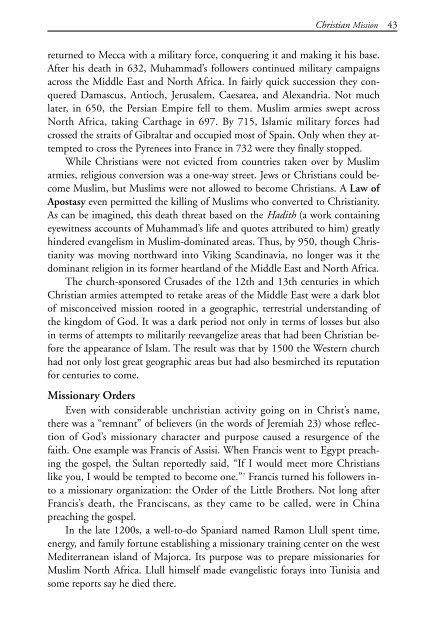discovering missions - Southern Nazarene University
discovering missions - Southern Nazarene University
discovering missions - Southern Nazarene University
You also want an ePaper? Increase the reach of your titles
YUMPU automatically turns print PDFs into web optimized ePapers that Google loves.
245187 Disc Missions ins 9/6/07 1:04 PM Page 43<br />
Christian Mission 43<br />
returned to Mecca with a military force, conquering it and making it his base.<br />
After his death in 632, Muhammad’s followers continued military campaigns<br />
across the Middle East and North Africa. In fairly quick succession they conquered<br />
Damascus, Antioch, Jerusalem, Caesarea, and Alexandria. Not much<br />
later, in 650, the Persian Empire fell to them. Muslim armies swept across<br />
North Africa, taking Carthage in 697. By 715, Islamic military forces had<br />
crossed the straits of Gibraltar and occupied most of Spain. Only when they attempted<br />
to cross the Pyrenees into France in 732 were they finally stopped.<br />
While Christians were not evicted from countries taken over by Muslim<br />
armies, religious conversion was a one-way street. Jews or Christians could become<br />
Muslim, but Muslims were not allowed to become Christians. A Law of<br />
Apostasy even permitted the killing of Muslims who converted to Christianity.<br />
As can be imagined, this death threat based on the Hadith (a work containing<br />
eyewitness accounts of Muhammad’s life and quotes attributed to him) greatly<br />
hindered evangelism in Muslim-dominated areas. Thus, by 950, though Christianity<br />
was moving northward into Viking Scandinavia, no longer was it the<br />
dominant religion in its former heartland of the Middle East and North Africa.<br />
The church-sponsored Crusades of the 12th and 13th centuries in which<br />
Christian armies attempted to retake areas of the Middle East were a dark blot<br />
of misconceived mission rooted in a geographic, terrestrial understanding of<br />
the kingdom of God. It was a dark period not only in terms of losses but also<br />
in terms of attempts to militarily reevangelize areas that had been Christian before<br />
the appearance of Islam. The result was that by 1500 the Western church<br />
had not only lost great geographic areas but had also besmirched its reputation<br />
for centuries to come.<br />
Missionary Orders<br />
Even with considerable unchristian activity going on in Christ’s name,<br />
there was a “remnant” of believers (in the words of Jeremiah 23) whose reflection<br />
of God’s missionary character and purpose caused a resurgence of the<br />
faith. One example was Francis of Assisi. When Francis went to Egypt preaching<br />
the gospel, the Sultan reportedly said, “If I would meet more Christians<br />
like you, I would be tempted to become one.” 7 Francis turned his followers into<br />
a missionary organization: the Order of the Little Brothers. Not long after<br />
Francis’s death, the Franciscans, as they came to be called, were in China<br />
preaching the gospel.<br />
In the late 1200s, a well-to-do Spaniard named Ramon Llull spent time,<br />
energy, and family fortune establishing a missionary training center on the west<br />
Mediterranean island of Majorca. Its purpose was to prepare missionaries for<br />
Muslim North Africa. Llull himself made evangelistic forays into Tunisia and<br />
some reports say he died there.

















